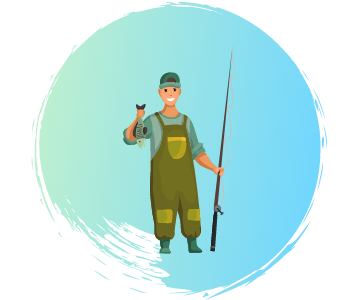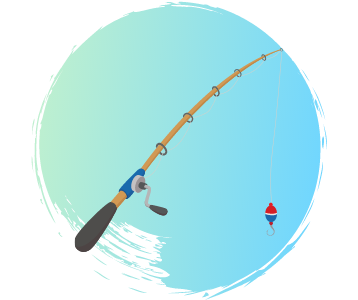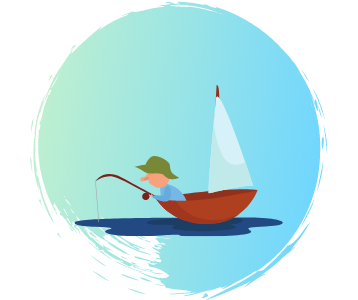Fishing Guides:
How To Catch Triggerfish
Trigger (Grey Triggerfish, Common Turbot, Cucuyo) are excellent tasting reef fish commonly caught around the Florida Panhandle and Atlantic Coast. They’re easy to find on reefs, wrecks, and other nearshore and offshore structures and put up a great fight on lighter tackle.
In this all-new guide, you’ll learn:
- Triggerfish biology
- Fishing tactics
- Insider tips
- Gear suggestions
Let’s get started.

Chapter 1:
Triggerfish Biology
To catch fish consistently, you need to know the behaviors and tendencies of your target species. So here we’ll go over some common facts about triggers, where they spend their time, how to identify them, and what they eat.

Where can I Catch Triggerfish?
You can find triggers on almost any offshore structure. In the Panhandle, where they’re most often fished for, you’ll spend a lot of time fishing artificial reefs, but any submerged structure from chicken coops to rock piles is likely to hold triggerfish, as well as red snapper.
Triggerfish tend to make nests on the seafloor to deposit their eggs in, defending them from any other fish that get too close by nipping at them. Once they hatch, the baby trigger head for the surface where they shelter and feed on grass until they reach large enough to hunt and descend towards the bottom.
How to Identify Triggerfish
There are a few kinds of triggerfish, but the grey triggerfish is the most commonly found and fished for trigger species in the Gulf of Mexico. They’re usually a dark grey to blue, with a lighter belly. They have a vertically flattened and round body shape, with a pointed dorsal fin on the top of their head.
Generally, triggers will weigh between 1-3 pounds with a legal minimum size of a 15-inch fork length at the time of writing. Larger fish can weigh up to ten pounds, but these are much rarer.
Triggerfish’s Preferred Food
Triggerfish are bottom feeders that feed primarily on invertebrates like shrimp, shellfish, sand dollars, squid, crabs, and urchins. They will happily take most cut bait, though, and are even known to nip at plastic lures, though you can rarely hook them on these.
Chapter 2:
Triggerfish Fishing Tactics
Triggerfish are usually targeted bottom fishing, either by drifting or anchoring on structures. You need to be precise, find a good location, and use the knowledge in this section to have the most success.

Where to Target Triggerfish
Targeting triggers is pretty easy, as you can find them in the same habitats as red snapper, and there are many public and private offshore structure coordinates. They tend to hang in schools above the structure they call home, so you’ll want to keep your bait off the bottom to avoid other fish.
Keep in Mind
One thing you must keep in mind with triggers is that they have tiny mouths. You’ll need to use small hooks and baits to make sure they can take the bait, and you can get a hookup. To further complicate this, they like to nip at your bait before taking it, though it’s easy to feel the difference between a nibble and a bite. Just be patient and don’t be discouraged if they steal the bait a few times.
Fishing in the Gulf of Mexico
In the Gulf, pretty much any offshore structure will hold some trigger. Anchoring and drift fishing are common ways to target them, but you need to be precise. If you’re twenty feet off the wreck, you might not get any bites even if triggers are on the structure. If you drift over them, you’ll need to make sure to pass directly over the structure you’re fishing as well.
Tackle for Triggerfish
You can use a variety of tackle for the trigger, but light tackle is the most fun. A medium/heavy spinning rod and 4000 size reel are great as it doesn’t overpower the fish and give you a great fight. If you don’t care about that, go ahead and use a solid boat setup like for grouper. Remember to scale down your hook size and leader so the trigger can take it.
Bait for Triggerfish
Cut baits work best on triggers, whether it’s a strip of squid or a small piece of mullet. They love shrimp, so threading a piece onto your hook or dropping down a live shrimp is a great option. You might find success with mussels, oysters, or artificial baits on your hooks as well, and that can help- get fewer bites from snapper and unwanted reef fish.
Rigs for Triggerfish
Rigs for triggers are simple, but two options work best. First is a sliding rig with an egg weight. They help you get your bait down quickly in a compact bundle and don’t give a ton of resistance from the lead when the fish bites. Alternatively, you can use a double-drop chicken rig with a lead on the bottom. For hooks, try to use 2/0 or smaller to ensure the trigger can get it and the bait into their mouths.
Chapter 3:
Insider Tips

1. Be patient.
Kind of like flounder, triggers take extra time to swallow your bait. They tend to peck at it and nibble a bit before fully taking it, making them infuriating bait thieves. The good news is it’s easy to tell when they take the bait, and you’ll feel a shift in weight instead of just a knock on your line. Be patient, and don’t try to set your hook until you feel that steady weight and pull, and you’ll be more successful with your hookups.
2. Safely release the fish if you can’t keep them.
Like other deepwater reef fish, triggers are used to spending time at depth. Your responsibility is to safely release any fish you don’t intend to keep or legally can not. Like snappers, be prepared to vent your fish or have a system for slowly lowering them to depth to help increase the fish’s survival odds after being caught. Not only is it generally a good thing to do, but increasing odds helps preserve the fishery and relieve population pressure.
3. Fish multiple size lines.
Triggers spend time on the same structures as other desirable fish like grouper and snapper, but it isn’t likely you’ll be hooking these larger species on the same lines. Jigging chicken rigs and catching triggers helps get bigger game fish off the bottom and get them interested in baits, so be prepared with larger rigs to catch these fish.
4. Be as precise as possible with boat and bait placements.
Triggers hold tight to the reef, even if they do tend to hang suspended above it. So if you anchor twenty feet in the wrong direction, you might not get a bite from a trigger even if they are there. Line depth is also significant to keep smaller snapper and unwanted fish from taking your bait instead. A typically four-ounce lead falls at around four feet per second, so you can count in your head to reach the proper depth you’ve marked fish with just a little basic math.
5. Try to find spots with less pressure.
Some of the best trigger spots will be private coordinates on small structures that people often don’t know about or fish. You’re more likely to find bigger fish on these without fishing pressure. Don’t ask people on Facebook for their private spots, but check around with your friends and some friendly people you know and see if they have any coordinates they’re willing to share.
6. Triggerfish have extremely tough skin.
Trigger’s skin is so thick and tough even an insanely sharp fillet knife won’t cut through it, just running it over the skin. Instead, there’s an art to filleting them, and it mainly revolves around getting your knife under the skin to cut upwards instead of down. Start around the gills to puncture in, then slowly work along the back and bottom towards the tail. You’ll have a much easier way of filleting a fish this way and won’t be dulling your knife.
Chapter 4:
Triggerfish Gear Recommendations

Best Triggerfish Rods
Fiblink Big Game Roller Rod

Check Price on Amazon
This rod in the heavier sizes may be overkill for a triggerfish, but the smaller sizes are a great, durable option for all reef fish. The rollers eliminate a lot of friction on the line and are great for hauling reef fish up from the depths.
13 Fishing Omen Black

Check Price on Amazon
The Omen Black is a fantastic spinning rod that has extreme sensitivity and balance. It’s the perfect light tackle option for triggerfish, small snapper, and jigging sabikis for bait. It feels good in your hands and has the power and durability to stand up to the hard fights you’ll get fighting deep water reef fish.
Best Triggerfish Reels
Shimano Stradic FL 4000

Check Price on Amazon
The Stradic is an overall great saltwater spinning reel. It’s got a smooth action, is sealed against saltwater, and has the drag power you need to keep reef fish from diving back into the structure. A simple rinse after a trip and a once over each year is all the maintenance it needs to keep performing in harsh saltwater environments.
PENN Special Senator Reel

Check Price on Amazon
Senators are powerful and simple reels that are great for trolling or straight dropping. These smaller versions (4/0) have the same features as their bigger, tuna fishing cousins, made for smaller targets. Powerful drag systems, huge line capacities, and an incredibly durable reel finishes off the package and makes an excellent conventional reel for triggerfish.
Best Triggerfish Baits
Shrimp is one of the best baits you can use, however strips of cut bait also work incredibly well. You won’t be using lures often, so stick to mostly cut baits and try a wide variety of them. Shrimp, oysters, mussels, crab, and cut mullet are all solid choices. You may even want to throw in handfuls of shucked shellfish to help get the trigger stirred up and ready to eat.
Chapter 5:
Final Thoughts
Fishing for triggers requires patience and precision, but it is some of the most rewarding fish you can catch since their meat usually outshines other more popular species when compared side by side. With excellent light tackle action and the high chances of a tasty mixed bag, triggers are a worthy fish to target whenever they’re in season.






